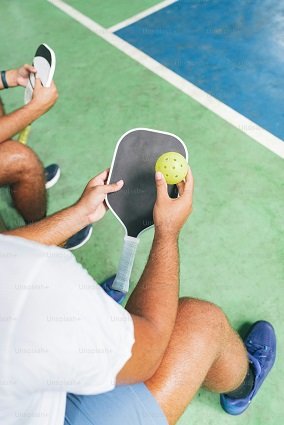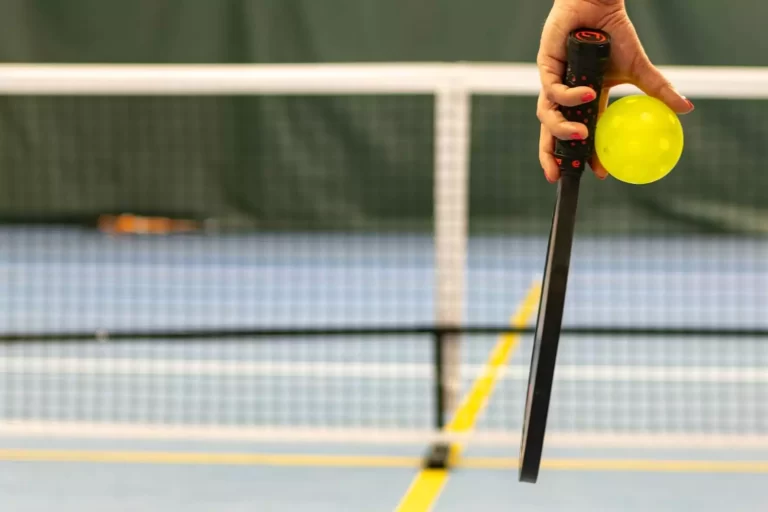 Are you a pickleball newbie wondering about the finer points of serving?
Are you a pickleball newbie wondering about the finer points of serving?
- One question that often pops up is: Do you have to let the first serve bounce?
- The answer might surprise you – it depends!
- Let’s dive in and get you serving like a pro!
Get ready to learn the serving bounce rules that will transform your pickleball game!
Pointers
- The Traditional Serve – Yes, Bounce is a Must: The classic pickleball serve requires both the serve AND the return of serve to bounce before either player can hit a volley (in-the-air shot).
- The “Drop Serve” – A Potential Gamechanger: Pickleball is currently testing a new type of serve, the “drop serve,” where you drop the ball and hit it after it bounces. This is not yet an official part of standard play.
Can you let the ball bounce before serving in pickleball?
Yes! It’s called a “drop serve.” You can drop the ball from any height and hit it after it bounces. This is a perfectly legal and often strategic way to serve.
What is the two-bounce rule in pickleball, and how does it apply to serving?
The two-bounce rule is a super important rule in pickleball:
- The Rule: After the serve, both the receiving team AND the serving team must let the ball bounce once on their side of the court before hitting a volley (hitting it in the air).
- Why it Matters: It levels the playing field. Aggressive serves can be tough to return, so this gives everyone a chance to get into the rally.
Why was the drop-serve introduced, and how does it benefit beginners?
- A Bit of History: The drop serve (or bounce serve) was introduced to make pickleball more accessible. Originally, everyone had to use an underhand volley serve. This motion was difficult for some players, especially those with limited mobility or new to racquet sports.
- Key Benefits for Beginners
- Easier to Master: Dropping the ball and striking it after a bounce is more intuitive and less technically demanding than a traditional volley serve.
- Focus on Placement: Beginners can focus on aiming the serve accurately rather than worrying about complex underhand serve mechanics.
- Reduces Frustration: The bounce serve provides a gentler entry to the game, avoiding immediate frustration with complex serve rules.
What are the specific rules regarding releasing the ball for a serve after it bounces?
- No Tossing: You can’t throw the ball up or down before you hit your bounce serve. It has to be a simple drop from your hand.
- Height Doesn’t Matter: There’s no specific height restriction on the drop. You can release the ball as high or low as you’re comfortable with.
- One Bounce Only: The ball must bounce once on your side of the court before you strike it.
Is there a time limit for hitting the ball after it bounces during the serve?
- Technically, No: There’s no official time limit in the rulebook. However, hesitating too long disrupts the flow of the game.
- Be Practical: Try to hit it soon after the bounce. It should be a continuous, fluid motion for the serve. Aim to have a rhythm to avoid giving your opponents an unnecessary advantage.
How does the number of bounces impact the serve? (Addresses a key point of confusion)
In pickleball, the serve is all about control and setting up the point. Here’s how the bounce factors in:
- Leveling the playing field: The required bounce on the serve and the return of serve (known as the “two-bounce rule”) prevents an immediate smash-and-volley situation. It gives both teams time to react and get into position.
- Promoting strategy: The bounce forces a slower pace for the first few shots, encouraging thoughtful shot placement and dinking (soft shots) rather than just relying on hard-hitting power.
What role does the non-volley zone play in serving after the bounce? (Important interaction between rules)
The non-volley zone (NVZ) is super important after the serve bounces for a couple of reasons:
- No cheap points: You can’t just blast a serve and charge the net to volley the return – you have to stay behind the NVZ line until the ball bounces on the return. This prevents the serve and volley advantage you see in tennis.
- Encourages rallies: Since both teams must let the ball bounce once after the serve and return, the NVZ rule forces those initial shots to be played as groundstrokes (ball hits the ground). This creates the foundation for pickleball’s exciting and often extended dink rallies.
Why is accuracy crucial when serving after the bounce? (Explores implications of the bounce serve)
- Sets the Stage: The serve starts every rally, so it sets the tone. A bad bounce makes it tougher to get a good return, throwing the receiving team off balance right from the start.
- Dictates Strategy: When you can master the bounce serve, you can place it strategically. Deep serves to the back line can push your opponents away from the net. Short, soft serves can force them to come forward and make them vulnerable to your next shot.
- Reduces Unforced Errors: A wild serve that bounces too high or goes out of bounds is essentially a free point for your opponents. Accuracy takes away that easy advantage.
How does the first serve bounce contribute to fair play in pickleball? (Addresses the rule’s purpose)
- Levels the Playing Field: In the early days of pickleball, powerful overhead serves dominated. The bounce rule creates a more even playing field, allowing for a mix of strategy and skill, not just raw power.
- Forces Variety: It encourages players to develop different serves. Soft, deep bounces, hard and low bounces…this variety keeps matches exciting and unpredictable.
- Encourages Rallies: Think of it as the “slow things down” rule. That bounce gives the receiving team a chance to react and set up a proper return, leading to longer and more engaging rallies.
Mastering the Bounce: Understanding the bounce rules is key to successful pickleball play.
- Traditional Serve: Stick to the standard bounce serve for most games and tournaments.
- Keep an Eye on the Drop Serve: The drop serve might become official one day, so keep track of rule updates!
Want to learn more about pickleball serving? Check out these helpful resources!
References
- USA Pickleball (Official Rules): https://usapickleball.org/
- Pickleball Channel (Serving Tutorials
